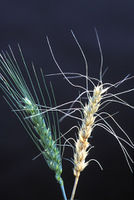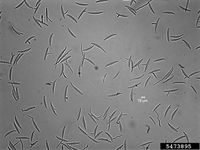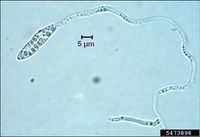Fusarium graminearum
| Literature database |
|---|
| 1656 articles sorted by: |
| • year (descending) |
| • research topics |
| • countries/regions |
| • host plants |
| • list of antagonists |
Fusarium graminearum Schwabe 1839
This fungus is the main causal agent of Fusarium head blight of wheat and barley (see also Fusarium culmorum), but also infects other cereals and other crops. For example, on soybean it causes root and seed rot as well as seedling damping-off. Other diseases on cereals are stalk, crown and ear rots. It can produce the mycotoxin trichothecene deoxynivalenol which contaminates the grain and is a serious threat to human and animal health. Large economic losses of cereals are attributed to the fungus world-wide. Infections are believed to start mainly through the flowers.
| Vernacular names | |
|---|---|
| • Deutsch: | partielle Taubährigkeit des Weizens Ährenfusariose |
| • English: | Fusarium head blight head scab of cereals Gibberella ear rot of maize |
| • Français: | brûlure des épis fusariose de l'épi du blé |
| • Português: | fusariose da espiga |
The fungus produces banana-shaped asexual macroconidia (3-5 celled, about 50 µm long) as well as filamentous sexual ascospores (about 20 µm long). Macroconidia disperse through rain splashes and ascospores by wind. The fungus will also persist in the soil on infected plant debris. The use and development of resistant grain varieties is considered to be the most appropriate control strategy. Control by crop rotation or the use of fungicides has been only partially successful.
Fusarium graminearum is a complex of more than 10 species which cause Fusarium head blight. Important members of this complex are:
Fusarium asiaticum
Fusarium austroamericanum
Fusarium boothii
Fusarium cortaderiae
Fusarium meridionale
Synonyms
Fusarium roseum
Gibberella zeae (teleomorph synonym)
- Other images of Fusarium graminearum (IPM Images, Fungi&Lichen-of-GB and Wikimedia Commons - click to enlarge)






